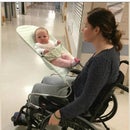Introduction: Grocery Restraint for Van / SUV
I'm a volunteer with the Tetra Society of North America.
We are a group with a wide variety of Maker minded people, who love the challenge of coming up with creative solutions to unique problems, that can arise from the day to day challenges of living with a disability.
This project was, to create a restraint for the back door of Zosia's van, to keep her groceries from falling on her when she opened the trunk. She had been using a bungee type restraint, but it was not holding her items secure enough.
Part of the challenge was to make it easily removable. Her spare tire is accessible, under the floor.
This Instructable will show how I made a tailgate to keep everything in place, allow Zosia to remove her groceries without fear of falling watermelons, and be easily removable.
Step 1: Materials
I wanted to to be light enough, that she could lift it out, if need be, and have simple, flush connections, that wouldn't interfere with removing the floor, to access the spare tire.
I started with a 55 gal polyethylene barrel. They are strong as heck, easy to cut and drill.
6 m x 1" webbing
8' aluminum U channel
2 D rings
3 buckles
3/4 m Heavy nylon canvas
Silicone sealant
2x bolt+nuts
4 washers
I started by cutting a middle section of the barrel, 10" wide. I used a hand saw, but a jig saw or a circular saw works too.
The next problem presented itself pretty quickly. I couldn't get the piece hot enough to get rid of the bend, from spending its life as a barrel.
I decided to add a ridged top and bottom to the piece to stop the bend. I used a piece of aluminum U channel, and drilled and screwed it to the plastic. This gave me a nice ridged base to work from. It did create a curve in the other direction, but that worked out to be an advantage later on.
Step 2: The Sleeve
When cutting the fabric for the sleeve, add an extra 3" to the height,
(3" + 10"), this allowed me to make a 2" flap that runs the length of the tailgate to use as a hinge, and attachment base, for webbing and buckles.
With a piece of heavy duty nylon canvas, I made a sleeve that the base would slide into.
Fold in half and sew up 2 sides, leaving one end open, that will be hand stitched closed, later.
Silicone sealant was added to the screws and aluminum trim, to help prevent abrasions of the fabric.
Photo 3 shows a detail of the hinge flap.
Leave a generous amount of space when you create the sleeve for the base to slide into. If you make it too tight, it will be hard on the fabric, and later when you attach the upper connections, because of the curve in the plastic, the fabric would pucker if too tight.
Step 3: Attachment Issues
Luckily there were some nice anchor points in this van. These points determined the design, to a degree, so you might have to vary the setup accordingly.
A folded piece of webbing with a D ring worked best for the bottom mounts.
A soldering iron works nicely to make holes webbing, and seals the edges at the same time.
To the bottom, hinge side of the tailgate, I added a piece of webbing that is sewn down to the full length of the hinge area. If you zoom in on photo 2, you can see the detail. You'll want to measure the 1" webbing double the length of the tailgate plus about 3 feet, for the buckle and extra for the adjustment tails, if you're using the same type of buckles. Velcro would work too.
The webbing, goes through the D rings, then comes back to the buckle that meets in the centre, to be snugged tight. All this is removable, by un-threading the buckle, and pulling it out of the D rings.
Hand sew the open end, closed.
For the upper attachments, I drilled a hole through all layers of the tailgate, about 2" down from the top edge of the tailgate.
I used a nut and bolt to attach a webbing loop, to hold one end of the buckle. I made small plastic washers to minimize any strain or wear from the fabric and webbing. See detail on photo 5.
The upper attachment to the anchor point, is adjustable, so the tailgate can be eased down if necessary, and snugged up vertical.
The curve that I mentioned earlier, turned out to be a perfect transition from the floor to the bumper. See photo 2.
Step 4: Done
So far it seems to be working out great for Zosia.
Be sure to post a comment, if you make it.
Check out the Tetra Society of North America, and think about volunteering.













